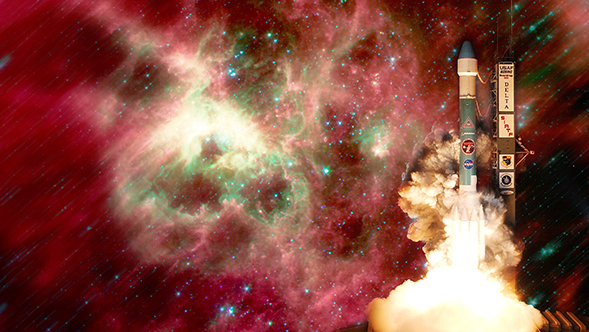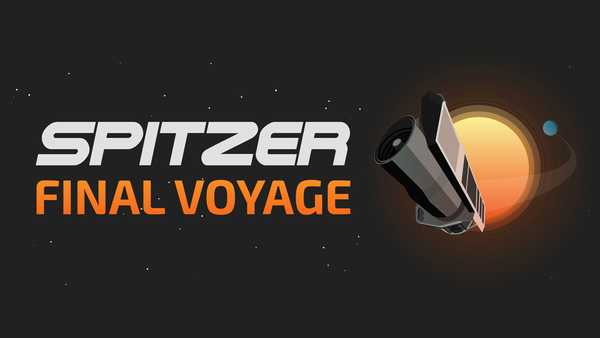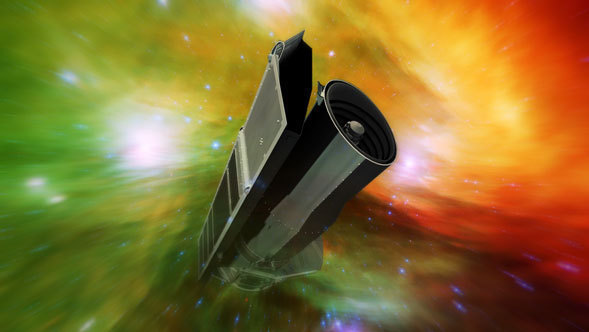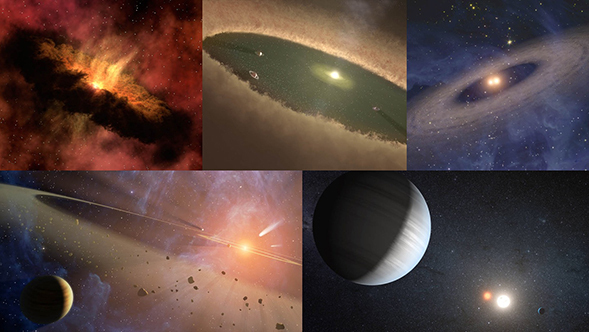
By William B. Latter | June 26th, 2019
For Mike Jura, an original SIRTF Science Working Group member, my advisor, mentor, and friend. It is my wish that all the truths he spent his life searching for have now been revealed to him.
We often think about Spitzer as being a 16-year-old. That is the time it has been operating after its launch on a Delta II Heavy rocket from Cape Canaveral. But, it is much older than that. Never a mission to not challenge its supporters, Spitzer was a long time in coming from concept to launch, with many pot holes in the road to keep things interesting. The initial Spitzer concept was first pitched to NASA Headquarters in 1971. It did not launch until 2003.
But, I am not here to talk about all of that history. Because, compared to those who saw Spitzer from concept to launch and beyond, I am but a newbie.
I first started work on the Spitzer project in July 1997. Twenty-two years ago. At the time, the observatory was called SIRTF, the Space Infrared Telescope Facility. The Spitzer Science Center, then called the SIRTF Operations Center (SOC) was just starting. I was one of the two first scientists hired to the SOC staff. There were a handful of us trying to figure out how we were going to operate this NASA Great Observatory on a significantly reduced budget. Prior to going to the SOC, I was a full-time research scientist.
Initially, my role with SIRTF was ill defined, because everything needed to be done, and we were just starting to staff up. I handled “User Tools,” and helped to define the instrument operating modes. Those had to be determined well before the instruments were built and the observatory and ground software developed, because the operations could, and did impact the entire observatory development in multiple ways. Later, I would become the lead for the Multiband Imaging Photometer for SIRTF Instrument Support Team. The challenges were many, and the pressure and stress of “getting it right” was intense. But, it was worth every minute, and I started to see my impact on nearly every aspect of the operations system. As SIRTF and the instruments grew into the Observatory it was supposed to be, we did not think of it as a thing we were just building as a job. No. It became part of us, as important as my left arm. We worked on it by day, thought about it in the evening, and dreamed about it at night. Mostly that was good. Sometimes it was too much. We all needed to have distractions. For me, that was running. I ran long, long distances in the desert, in the summer. I both escaped and solved many work-related problems while “out there.”
SIRTF brought me more than job satisfaction. I met my wife there, too. Deborah had been the US Resident Astronomer for the Infrared Space Observatory (ISO) and was stationed for three years near Madrid, Spain. When she returned, she became the lead for the Science Operations Team at the (then) SIRTF Science Center (SSC). By then the staff had grown and roles well defined. Our day to day work did not overlap very much, but we collaborated on a number of problems that needed solving. One such problem was a proper definition and diagram of the SIRTF focal plane – how the instruments would see the sky relative the each other and how those openings in the focal plane were placed relative the observatory’s rotational axes. This is not as easy as it sounds, because the optics played a role in inverting and rotating how the focal plane was projected. The only time we would know if we really got that right was the first time SIRTF would take data in orbit.
After seven intense and all too short years, I finally stood with Deborah on a beach in Cape Canaveral as we watched SIRTF lift off into space in a spectacular night launch. We had tears in our eyes. We had done it. We had helped to put a Great Observatory in space.
But, would it work? Launch is difficult on a satellite. It is shaken hard, pushed by intense g-forces, and let go to float away and begin its life alone. We had to wait. It would be hours before we would know much of anything.
Well, things did not start off exactly as planned. When we learned the status of the Observatory, it was initially found to have entered Safe Mode. That happens autonomously if the flight computer determines there is an anomaly that needs to be corrected before continuing. With that, my role was to wait nervously as the Anomaly Team went into action for the first time, and a bit sooner than expected. Deborah was a member of the Anomaly Response Team, so she had a job to do right away. As it turned out, this was not a crisis. The Observatory did the right thing when it detected a communications error, which was a ground fault, not one with any of the flight system. A recovery plan was made. All was well. We went back to “normal” life and waited for the next major event – the opening of the telescope cover.
There is no need to go into detail about how those significant events went. The Spitzer Space Telescope completed all events and went through its in-orbit check-out period on schedule. Deborah and I wanted to find out if we got the focal plane right. We had waited years for that one moment when we stood silently over the instrument scientist as the first image was displayed. Yes, we had gotten it right. If not, there would have been a much different image.
That was the most intense and fun time of the entire development cycle. We saw real data. We saw real astronomical objects at wavelengths never before examined. We learned about the instruments, the telescope, and the spacecraft – how well they worked, what did not work so well (very little), and we started to do science with some of that early data. A firehose of information was pointed directly at us. We had planned for this. But, until it actually happened, we could not appreciate how that would really feel. It was hard. It was tiring. It was exhilarating. We were on our way to discover new truths about the Universe.
It was time for science.
The initial “cold mission” (when Spitzer was cooled by a tank of super-fluid helium) was a total success. It happened as we had hoped and planned. The three instruments preformed nearly flawlessly, and the telescope was perfect.
The astronomical community came out en mass to propose for Spitzer observations. New discoveries were made. Our understanding of the Universe and how it works was moved forward in profound ways. We confirmed old ideas that could not be tested without Spitzer. We learned fundamentally new things.
After a couple of years, Spitzer operations became something like routine. I found I was better at the high stress, never the same thing each day, type of work that is development. An opportunity opened up and I moved on, reluctantly. I went on the European Space Agency’s Herschel Space Telescope and then the NASA/DLR Stratospheric Observatory for Infrared Astronomy (SOFIA).
However, it seems for me, nothing remains the same for long. An opportunity at NASA Headquarters in Washington DC was offered and I accepted. I am now a NASA Program Scientist in the Astrophysics Division.
To my absolute delight, I was quickly assigned to be the new NASA HQ Spitzer Program Scientist. From this position, I oversee the Spitzer Space Telescope operations and ongoing mission. Mostly, my role at this point is to not break anything. Through its long mission, the Spitzer operations teams have become well-oiled and extremely effective.
It was like coming home after a long trip away. It is also a bittersweet return.
The limits of technology, orbital mechanics, and simply not being designed for such a long life at a very large distance from Earth make it time for the Spitzer mission to end. That day will be January 30, 2020. The day before, Spitzer observations will stop. Its time as a producer of unique and precious data will end. The Observatory will wait quietly for a day.
Then, with a single stroke of a computer key, the command sequence to turn off the observatory will be sent. It will take some 15 minutes for that command sequence to travel through space to be received by the Spitzer computers. Spitzer will then sleep after a long, productive life. Forever to float in deep space.
As we had traveled to Florida for the first day of Spitzer’s life in space, my wife and I will travel to California and JPL for its last day. We will be there with our friends who became family. We will hold hands as the command sequence is sent. There will be tears. Tears of sadness and of joy. Sadness because something truly grand has come to an end. Joy for the success we have achieved. Joy because we will be there with the family of which we have become a part. Joy to be together again as we all say a fare thee well to the other family member we sent off on its own to learn the truth in the vastness of space, to seek the imponderable. And so, it did.
Spitzer is more than a piece of hardware to many. To me, it is the culmination of a dream. A dream that I might one day have an impact on the world of science, to help change textbooks, to learn the truth about how the Universe works. While my own research has had a minor impact, it has been through my support of the Spitzer Space Telescope and the astronomical community that I have had that impact I dreamt about. By helping to make Spitzer work, and providing the community and the world with an amazing tool, I made science happen. I could not have asked for more.
While the observatory itself will come to an end, Spitzer’s legacy will continue. The data taken will be studied again and again, and discoveries will continue to be made at least into the next generation of scientists. Its impact to science will never diminish.
Spitzer will live on forever.

 Seeing Spitzer
Seeing Spitzer
 Two Decades of 'Growing Up' with Spitzer
Two Decades of 'Growing Up' with Spitzer



